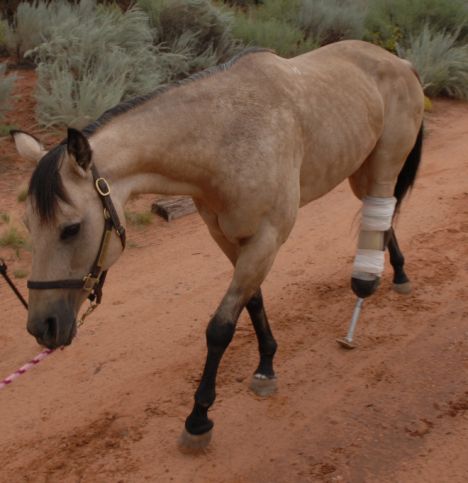Breaking a Leg- What It Means For Your Horse
 Perhaps one of the most frightening things for any horse owner, especially a young one, is the prospect of their horse breaking a leg. We have all heard of or seen the horror of a horse stumbling on the race track and having to be euthanized (we no longer shoot our animals when they break a leg, euthanasia is more humane). But why are these horses so often euthanized? Does every horse that breaks its leg face this same fate? Thankfully, no. The process of dealing with a broken horse leg is one of finance, time, and success factors. Perhaps one of the most frightening things for any horse owner, especially a young one, is the prospect of their horse breaking a leg. We have all heard of or seen the horror of a horse stumbling on the race track and having to be euthanized (we no longer shoot our animals when they break a leg, euthanasia is more humane). But why are these horses so often euthanized? Does every horse that breaks its leg face this same fate? Thankfully, no. The process of dealing with a broken horse leg is one of finance, time, and success factors.
In order to first understand what the likelihood is that your horse will survive a break, you must understand what sorts of breaks your horse can suffer. A hairline fracture is a small crack in the outer layer of the bone. The horse may show mild lameness and tissue damage from the break will be minimal; however, these can be compounded by continued work and become worse. Simple fractures are only one fracture line in the bone, without displacement, while a compound fracture often has the bone breaking through the skin and causing a high risk of infection. Comminuted fractures and be combined with compound fractures and have more than one break or even crushed bones. It is possible for any of these to be combined, and your vet should be called immediately if you suspect your horse has fractured or broken their leg. Only you and your vet can decide if treatment is the best course of action or if euthanasia is the more humane option. Do not despair, however, if things look bad. Veterinary medicine today is capable of wonderful things and if you have the finances and time to set aside to rehabilitating your horse after a break then you will be able to do so. One thing to remember is the location of the break will affect their lifestyle for the rest of their life and you will have to take into consideration the level of pain they may continue to experience when making your decision. Remember, as hard as it may be to make the decision to euthanize, as a responsible horse owner it is your job to make the decision that is best for your horse and not yourself. So when it is highly likely that you will have to euthanize? In the case of compound and comminuted fractures, only ten percent of horses survive. It depends on the break. Small breaks in the foot or the scapula can be treated with rest or corrective foot repair and surgery; however breaks to the humerus or other large bones is considered life threatening. Consider your horses recovery in your decision. It is difficult to keep a horse from moving and that is often what is necessary for them to heal well and properly. Know your horse, if they will not do well with six months of rest then you will have to carefully weigh your options as the worst thing would be for them to do too much and re-fracture or worsen the break. Keep your horses safe and be sure you provide them with everything possible to help prevent having to make this decision. Do not push your horse too hard, make sure your paddocks are free of holes they could trip in, keep your horse well shoed, and use common sense! The best way to deal with a broken leg, frankly, is never to have one. Related Articles Breaking a Leg- What It Means For Your Horse
Deadly Equine Diseases
Tips for Keeping Flies Under Control
Horse Inspection Checklist
Five Most Common Horse Diseases
How to Spot a Malnourished Horse
Top 10 Most Poisonous Plants for Horses
Feeding and Rebuilding a Malnourished Horse
Helping a Horse Living with Cushing's
How to Treat Abscesses on Your Horse
Colic and Your Horse
Confirming That Your Horse Has Rabies
Helping a Pregnant Mare
Handling a Rattlesnake Bite to Your Horse
Being Aware of Tetanus and Your Horse
Preventing Thrush in Your Horse |